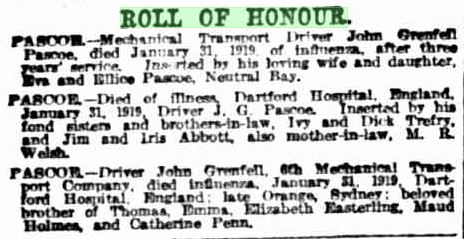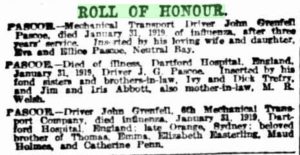On 16 January 1919 John Grenfell Pascoe, a driver with the 6th Australian Corps Troops Mechanical Transport Company, travelled from France to England on furlough. Peace had been declared less than two months earlier. Driver Pascoe had seen two and half years’ active service was awaiting transportation home to Australia.
Ten days into his furlough John was admitted to the Australian Auxiliary Hospital in Dartford. He was experiencing severe headaches and pains in his back and legs. John’s temperature rose rapidly following his admission and he developed a cough. On 29 January it rose to 105.2ºF (40.6ºC) and he began to expectorate blood. He died at 5am on 31 January 1919; the cause of death was noted as influenza and pneumonia. John was 44 years old.
John was buried at Brookwood Military Cemetery in Surrey on 4 February. The Officer in Charge of Records, AIF, London, observed:
The deceased soldier was accorded a full Military funeral, Firing Party, Bugler, and Pallbearers in attendance.
The coffin was draped with the Australian flag, and borne to the graveside, where the Last Post was sounded and the burial service conducted by Chaplain the Rev Crotty, C of E of the AIF London.
Administrative Headquarters AIF London were represented at the funeral.
John was born in Lucknow in 1874. He was one of 15 children born to Thomas Henry Pascoe and Hannah Ellis nee Bothera. Five of John’s siblings died during infancy. Thomas and Hannah had married in Cornwell in 1855 and migrated to Australia in 1856. They settled in Castlemaine, Victoria, but moved to Forbes in 1862 and Lucknow in 1867. Thomas became the manager of the Phoenix Mine at Lucknow, and, in 1887, purchased the Perseverance Hotel.
John was educated at Orange Public School where he served in the cadets. In 1900 John married Eva Welsh in Orange and their only daughter, Violet Ellice Grenfell Pascoe, was born in 1901.
By 1916 John and his family had moved to St Peters in Sydney, where he was employed as an engine driver, presumably with the railways. John enlisted on 2 May 1916 and embarked for overseas service on 22 August. He disembarked in Plymouth in October 1916 and undertook further training with the Australian Details No 3 Camp at Parkhouse and the Pioneer Training Battalion at Perham Downs before proceeding to France in late February 1917.
In June 1918 John was admitted to the 1st USA General Hospital, France, with a malignant ulcer of the gum. He received two weeks’ treatment and was transferred to the 1st Convalescent Depot, where he spent almost two months recovering. Driver Pascoe rejoined his unit in late August 1918. He continued to serve without incident until being struck with influenza in January 1919.
John Grenfell Pascoe is commemorated on the Holy Trinity Church Orange Honour Roll, the World War I Roll of Honour on the southern face of the Orange Cenotaph and on panel number 181 on the Roll of Honour at the Australian War Memorial in Canberra
In 1923 the Anzac Memorial Avenue of trees was planted along Bathurst Road to commemorate fallen WWI soldiers. A tree was planted in honour of “Pte JF Pascoe”, presumably John. It was donated by Joseph Pascoe. Very few of the trees are still standing today.
Sadly, John Grenfell Pascoe was not the last serviceman from the Orange district to die post-armistice from disease or injuries. Two other men followed him: Thomas Reuben Haydon on 6 February 1919, and George Frederick Reed on 7 March 1919.


